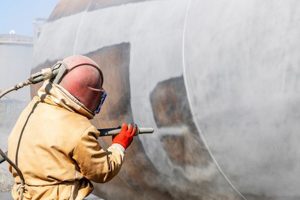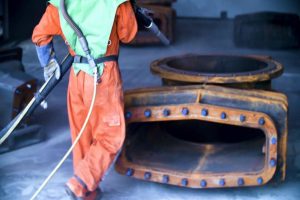Home / News & Blog / 5 Necessary Precautions for Keeping Sandblasting Safe
Sandblasting is an essential process across various industries, from cleaning surfaces to preparing materials for finishing. While highly effective, it presents a range of hazards that can compromise safety if not managed correctly. The high velocity of abrasive materials like sand or glass beads, combined with the force of air, creates risks for both operators and the surrounding environment.
Whether you’re a seasoned professional or a DIY enthusiast using sandblasting equipment, safety should be a top priority. In this article, we’ll explore the five most necessary precautions you must take to ensure that sandblasting remains safe and efficient.
Sandblasting involves flying particles that can cause serious injury. The first and most important precaution is wearing the right personal protective equipment (PPE). The blasting process produces high-speed projectiles that can damage your eyes, lungs, and skin, so full-body protection is non-negotiable.

Key PPE for sandblasting includes:
-Blast Helmet: A full-face blast helmet with a secure visor prevents direct contact with abrasive particles.
-Respirators: Silica dust and other fine particles can lead to serious lung conditions like silicosis. Ensure you’re using an
appropriate respirator with filters rated for sandblasting operations.
-Heavy-Duty Gloves: Your hands are at the most risk, so reinforced gloves made of leather or a similar material are
essential.
-Protective Clothing: Long sleeves, full-body suits, and steel-toed boots will help protect your skin from abrasive
rebound.
Tip: Never cut corners on PPE. Skimping on quality gear increases your risk of long-term injury or exposure to harmful
materials.
Proper ventilation is critical in sandblasting environments to reduce the accumulation of harmful airborne contaminants, especially when working indoors. The dust and particles generated during the blasting process can linger in the air, making it unsafe for anyone nearby.
-Use Dust Collectors: Industrial-grade dust collectors should be installed to capture airborne particles at the source. This reduces the amount of dust that enters the surrounding environment.
-Ventilate the Workspace: For confined areas, use fans or industrial ventilators to maintain good airflow. If possible, work in open or semi-open spaces where natural ventilation can further aid in dispersing dust.
-Monitor Air Quality: Especially important in enclosed spaces, monitoring devices should measure air quality to ensure that levels of dust, silica, or other hazardous particles remain within safe limits.
Tip: Always keep the area free of excess dust and use barriers to keep other personnel away from the sandblasting zone.
One of the biggest dangers associated with sandblasting is exposure to crystalline silica, which is commonly found in many abrasive materials. When inhaled, silica dust can cause severe health problems such as lung cancer and silicosis.
The following steps will help manage and reduce silica exposure:
-Choose the Right Abrasive: Where possible, use non-silica abrasives like steel grit, aluminum oxide, or glass beads. These alternatives offer similar results without the harmful dust.
-Wet Blasting: Wet blasting can significantly reduce dust levels, as water or another liquid is mixed with the abrasive material to minimize the spread of airborne particles.
-Silica Monitoring: In professional settings, continuous monitoring of silica levels ensures that concentrations stay below the legally permissible exposure limits.
Tip: Substitute hazardous abrasives with safer alternatives whenever possible to mitigate long-term health risks.
Sandblasting equipment undergoes immense stress during operations, making regular inspection a crucial step to prevent accidents. Damaged or malfunctioning equipment can lead to serious injuries, loss of control, or equipment failure.
Here are some aspects to inspect:
-Blast Hose and Nozzle: Check for cracks, leaks, or wear in the blast hose, and ensure that the nozzle is clean and properly fitted.
-Air Compressor: Confirm that the air compressor is working efficiently, providing stable pressure without fluctuations.
-Abrasive Material: Make sure that the abrasive being used is free from moisture and contaminants, as clogs or inconsistencies can disrupt the blasting process.
-Gaskets and Seals: All gaskets and seals should be tightly secured and free from cracks or wear, as compromised seals can lead to leaks of pressurized air or abrasive material.
Tip: Establish a regular equipment maintenance schedule to ensure safety and optimal performance. Replace worn components immediately to avoid equipment failure during operation.

Finally, proper operation of sandblasting equipment is essential for both safety and efficiency. Whether working alone or as part of a team, you should follow well-established protocols to minimize risk.
Some key safety protocols include:
-Clear Communication: If working in teams, establish clear communication to coordinate movements and ensure everyone understands the task at hand.
-Start-Up and Shut-Down Procedures: Always follow the manufacturer’s start-up and shut-down guidelines to avoid accidents caused by sudden pressure changes or equipment malfunctions.
-Barrier Protection: Use physical barriers or shields to protect bystanders from flying debris or dust, especially in open environments.
-Distance and Angle: Maintain a safe distance from the surface being blasted, and work at an angle to prevent the abrasive from ricocheting back towards the operator.
Tip: Conduct safety drills and refresher training sessions for operators to ensure that everyone remains up-to-date on best practices.
Sandblasting is a powerful technique, but it comes with inherent risks that must be properly managed. By prioritizing personal protection, maintaining equipment, ensuring proper ventilation, and following safe operation protocols, you can significantly reduce the chances of accidents and long-term health issues.
Remember, safety in sandblasting isn’t just about compliance with industry standards – it’s about protecting yourself, your team, and your work environment from preventable harm. Following these five essential precautions will help keep every sandblasting job both safe and effective.